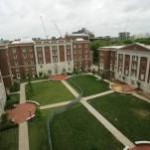Vanderbilt First University in Tennessee Recognized for “Green” Building
By Princine Lewis, Vanderbilt News
 Vanderbilt University is the first university in the state to be recognized for environmentally friendly construction by the U.S. Green Building Council’s Leadership in Energy and Environmental Design (LEED) Green Building Rating System.
Vanderbilt University is the first university in the state to be recognized for environmentally friendly construction by the U.S. Green Building Council’s Leadership in Energy and Environmental Design (LEED) Green Building Rating System.
LEED is the nationally accepted benchmark for the design, construction and operation of high performance green buildings. Organizations must apply for the certification which is recognized nationwide as proof that a building is environmentally responsible, profitable and a healthy place to live and work.
The council has awarded the university Silver level certification for Crawford and Sutherland houses, two new residence halls built as part of The Commons, Vanderbilt’s new first-year student community scheduled to open in fall 2008 as the first phase of the university’s residential college system.
Among the sustainability elements on which the council evaluates buildings are site selection, energy efficiency, water efficiency, indoor environmental quality, materials and resources. The council awards Basic, Silver, Gold and Platinum ratings. Vanderbilt is one of only three organizations in Tennessee that has Silver level certification.
Vanderbilt’s application for and achievement of LEED certification was a partnership between the university’s administration and its students. Vanderbilt student organization SPEAR (Students Promoting Environmental Awareness and Recycling) was the impetus behind the university’s applying for LEED certification.
“SPEAR was passionate about enhancing the university’s sustainability efforts and at their urging we agreed to pursue the certification as an example of the student-faculty-staff partnerships The Commons was designed to foster. While we regularly incorporate environmentally friendly elements in our construction projects, we had not sought certification for any of our buildings,” said Judson Newbern, Vanderbilt associate vice chancellor for campus planning and environmental health and safety.
“I am honored and grateful to know that SPEAR has had impact on this university by initiating the LEED certification. Not only does the Silver certification benefit the environment through energy efficiency and material conservation, but it also raises awareness at Vanderbilt that being green goes beyond just recycling and saving rain forests,” SPEAR President Brent Fitzgerald said.
Frank Wcislo, Dean of The Commons, 10 faculty members and staff from the Office of the Dean of Students will live among first-year students in The Commons to create a unique living-learning environment. In addition to the two LEED-certified residence halls, Crawford and Sutherland houses, five other buildings in The Commons have also been submitted for LEED certification.
“These buildings are part of one of the largest construction projects in the history of our campus and will affect students for generations to come. They will stand as a lasting legacy of this generation of Vanderbilt leaders, including students who have been at the forefront of working on environmental issues. LEED certification of these two residential houses reflects the dedication of The Commons to helping our students become leaders in the diverse, democratic and global communities of the 21st century,” Wcislo said.
Among the environmentally friendly features of Crawford and Sutherland Houses and The Commons are low-flow or waterless fixtures, state of the art HVAC systems, flooring made of bamboo (a resource that renews quickly), high efficiency kitchen exhaust systems, natural lighting in atriums and stairwells, motorized window shades to reduce heat and glare, and pervious concrete pavement which absorbs water rather than creates runoff. Most of the new materials being used in Commons structures have come from vendors located within a 500-mile radius of Nashville in order to conserve energy.
“We’ve really tried to think of creative ways to use and re-use building materials at The Commons – we used recycled glass in the new terrazzo flooring, and the carpeting also contains a high recycled content,” said Tony Fort, project manager for The Commons in the Campus Planning and Construction Office.
Also, old oak chairs from the university’s libraries were reused for seating in the Dining Center, according to Keith Loiseau, a LEED-accredited architect at the university.
When the Hill Center, the old dining facility, was torn down in order to build the new dining center, nearly 75 percent of the materials were salvaged, recycled or sold.
Sandstone from the Hill Center was used in the patios of the new dining center and 150 tons of limestone excavated from The Commons construction site was used to create the landscape sculpture Star Chamber at the university’s Dyer Observatory.
In addition to Vanderbilt, two other Tennessee organizations have Silver or Gold level LEED certification. The Joint Institute for Computational Sciences at the Oak Ridge National Laboratory and the Nestle Pure Life Water Bottling Plant in Red Boiling Springs have Silver level certification. A second research facility at the Oak Ridge National Laboratory has Gold level certification.
For more news about Vanderbilt, visit VUCast – Vanderbilt’s News Network.

Leave a Response